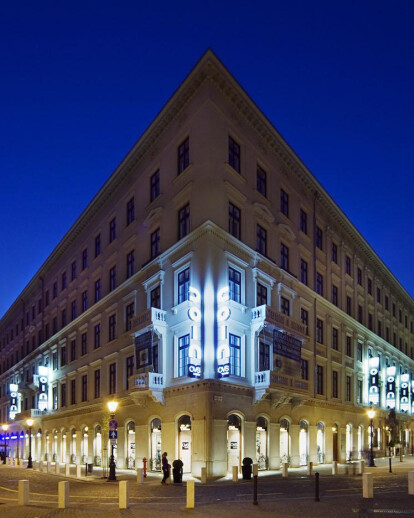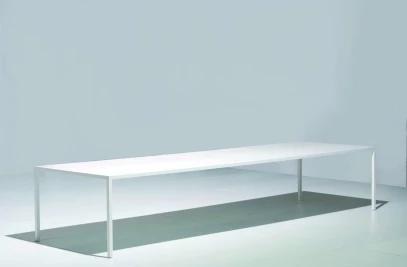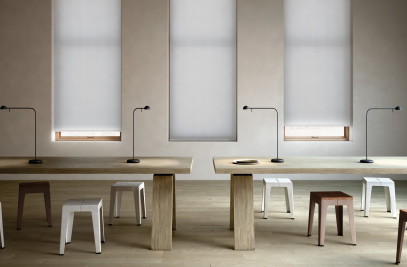| Element | Brand | Product Name |
|---|---|---|
| Floor lamp | Davide Groppi srl | |
| wall lamp | Vibia | |
| chairs | Magis spa | |
| Kitchen with island | Cesar | |
| Marble table | MDF Italia | |
| Facade | Hunter Douglas Architectural |
The architect Mihaly Pollack, known also for the design of the Hungarian National Museum, designed the original building as a two-storey residence built between 1821 and 1824 for the wealthy merchant Josef Wurm. Subsequently it became a collage as the architect Jozsef Diescher increased it in height, in the 1860s and later Alajos Hauszmann, the designer of the Buda Castle, added the neo-baroque lobby and central pavilion. Of course by the time Gruppo Fingen, the Italian property company purchased the building, nothing of its former splendour remained. It was during that transition from the communist era to the modern day Hungary that the building was given a new lease of life and restored well beyond its former glory, perhaps a touch too perfectly, to become what is now Palazzo Dorottya.
The brief was to create a mixed-use project with luxury shops on the ground level, offices on the “Piano Nobile”, and residences on the floors above. A simple enough proposition; except that of course the building by the end of the 20th Century had become so dilapidated and dangerous that these plans looked too ambitious when considering the extent of new insertions proposed. The car park was designed as a 4 story 20m hole in the ground, well below the nearby Danube water table. In addition of course the Monuments Authority – this is a protected national monument – was the worst of its kind in terms of its bureaucracy and requirements. To make matters worse, the authority required that the central pavilion, which was used as a banking hall, be retained in place while this 4-story car park was dug and built underneath. Naturally this idea was nipped in the bud by Avci Architects’ Anglo-Saxon rational approach and it was agreed that the pavilion could be demolished and rebuilt as a replica. Subsequently the retained parts of the building consisted of the main feature corners, with the stairs, the main “back wall” of the old building, which was to be retained within the apartments as an expression of the massive structure of the old building where possible, and the first two floors of the main facades. Everything else was demolished and rebuilt, in a sense better than the original. The building for all other purposes had to act in the same way as a totally new building might, and there fore the existing facades and elements retained became merely a skin to the inner modern concrete skeleton.
In contrast to the extreme conservatism of the Monuments Authority, the municipality “Aesthetics Committee” took the view that what was new in the whole should be completely modern in its style and architectural intent rather than try to mimic the old architecture. There fore we had initially a very free hand in the design of the interior courtyard. The resulting building has a Janus like inner and outer face, which naturally is a pleasant surprise for the privileged visitor who has the possibility of seeing both these facades. The main entrance to the central hall and the larger unit at the heart of the ground floor would be from the 19th Century Hauszmann doors on axis with the central hall, although alternative entrances from the South and West axis would also be provided to acknowledge the symmetrical planning of the existing old building. Similarly the arcades, which surround the outer edges of the building, would be treated as separate shop units accessible directly from the street, to allow these to work independently of the central space. In essence this allowed the street level activity of the main Vörösmarty Square to move further towards Dorottya thus facilitating the re-stitching of the urban fabric in the area. The Streets to the South and East were pedestrianized to further emphasise this reclaiming of urban territory by human traffic rather than cars.
The offices occupy the taller spaces of the Piano Nobile, and are accessible from two corner locations only on the south-west and south-east where separate lifts take visitors directly to the first floor. Concierge’s sit at both these corner locations to control access. Other wise the two northern corners are reserved for residential only.
The existing building had floor-to-floor heights that are consistently around 3.5m nearly all the way to the top of the building. There fore it was possible that in the new inner courtyard areas these higher floors could be used to increase the occupied area of the building by one further floor, which would be a normal residential height, while at the same time giving us the opportunity to create some interesting duplex apartments that feel more spacious through the use of double height connections. An additional mezzanine floor added to the roof spaces in a similar way meant that a further total of 2,000sqms could be added to the sellable apartment areas of the whole building. Naturally this “intelligent” use of the section was much welcomed by the investor, and certainly not resisted by the municipality as it increased density without further affecting the magnitude of the building on site.
With the overall plan depth of the building increasing to between 15-18m meant that with a central corridor plan there would be an awful lot of repeating single sided linear plan types. With this approach one would also waste a great deal of space on circulation. The organisation of the 2nd and 5th floors there fore has the two-sided corridor access, where as the 3rd and 4th floors have “dead-ends” in the middle sections where apartments carry across from the courtyard to the outer street walls. This produces the sub-Corbusian Unité d'Habitation plans which have both light and views from two directions.
The courtyard is treated with a series of controllable shading devices, which minimise heat gain, while providing much needed privacy between apartments. The double height winter garden/conservatories are used as solar collector spaces, which in the colder sunny seasons provide much needed heat gains. The building is highly insulated and provides comfort conditions in both winter and summer with a minimum of energy cost.
Products Behind Projects
Product Spotlight
News

FAAB proposes “green up” solution for Łukasiewicz Research Network Headquarters in Warsaw
Warsaw-based FAAB has developed a “green-up” solution for the construction of Łukasiewic... More

Mole Architects and Invisible Studio complete sustainable, utilitarian building for Forest School Camps
Mole Architects and Invisible Studio have completed “The Big Roof”, a new low-carbon and... More

Key projects by NOA
NOA is a collective of architects and interior designers founded in 2011 by Stefan Rier and Lukas Ru... More

Introducing the Archello Podcast: the most visual architecture podcast in the world
Archello is thrilled to announce the launch of the Archello Podcast, a series of conversations featu... More

Taktik Design revamps sunken garden oasis in Montreal college
At the heart of Montreal’s Collège de Maisonneuve, Montreal-based Taktik Design has com... More

Carr’s “Coastal Compound” combines family beach house with the luxury of a boutique hotel
Melbourne-based architecture and interior design studio Carr has completed a coastal residence embed... More

Barrisol Light brings the outdoors inside at Mr Green’s Office
French ceiling manufacturer Barrisol - Normalu SAS was included in Archello’s list of 25 best... More

Peter Pichler, Rosalba Rojas Chávez, Lourenço Gimenes and Raissa Furlan join Archello Awards 2024 jury
Peter Pichler, Rosalba Rojas Chávez, Lourenço Gimenes and Raissa Furlan have been anno... More































